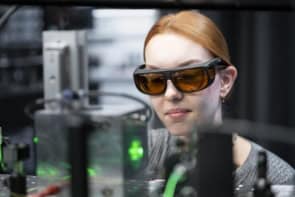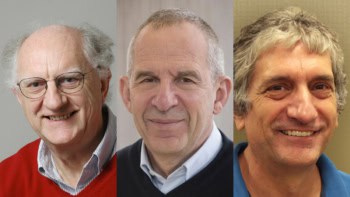The quest is on to make terahertz sources that are small, portable and capable of operating at room temperature. Such a breakthrough could lead to advances in everything from cancer screening to astronomy, reports Keith Cooper
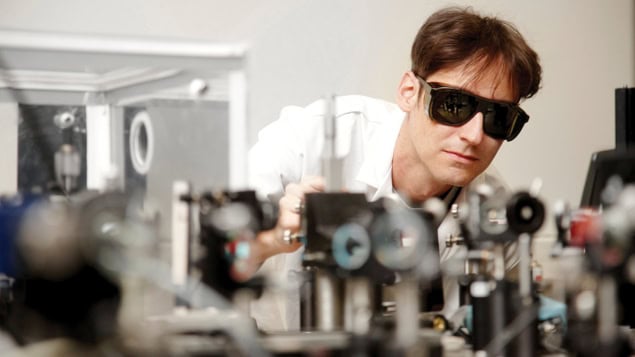
Scientists have spent the last century or so busily plundering the electromagnetic spectrum, adapting almost every wavelength possible for all manner of applications. We listen to music through radio waves, cook our dinners using microwaves, turn our televisions on with infrared lasers, find forged bank notes with ultraviolet light and identify broken bones with X-rays.
Yet there is one region of the electromagnetic spectrum that has – until recently – remained relatively untouched. To astronomers who detect it from molecules in gas clouds in the farthest reaches of our galaxy, it’s known as submillimetre radiation. To the rest of the physics community, it’s better known by its frequency: terahertz.
Sandwiched between microwaves and mid-infrared light, terahertz radiation runs from about 0.3 to 10 THz (where 1 THz = 1012 Hz). Its potential is great: this kind of light could transform cancer screening, sniff out explosives and drugs, or communicate huge amounts of wireless data. However, terahertz radiation has been rarely exploited so far because terahertz generators do not come in a one-size-fits-all format.
Synchrotrons can produce lots of terahertz radiation, but they are big, centralized facilities. While you can create pulses of terahertz radiation relatively easily by firing near-infrared titanium-sapphire lasers at a semiconductor, this technique of “time-domain spectroscopy” – which can probe ceramics, plastics and other materials looking for hairline fractures or structural abnormalities – is expensive. It also lacks the power required by other applications.
In 2002 a new way of creating terahertz radiation was invented that, researchers hoped, would revolutionize terahertz physics. Known as the terahertz quantum cascade laser (QCL), this device has a bigger power output and a better signal-to-noise ratio than all previous terahertz devices. Hopes for it were high, but progress in developing compact, room-temperature terahertz QCLs proved slower than expected. Several big challenges still remain – so what will it take for terahertz QCLs to take the terahertz throne?
Two in one
One promising application of terahertz technology is screening for various types of cancer. That’s because if you expose cancerous parts of the body to terahertz radiation, they seem to have a different spectral response compared with healthy tissue. And because terahertz radiation has a lower energy than, say, X-rays, it doesn’t have the same destructive, ionizing effects on the body.
To be an effective source of cancer screening, however, terahertz scanners need to be portable, easy to use and cheap. The problem is that a conventional QCL-based terahertz scanner is bulky. It not only needs a source of terahertz radiation – the QCL itself – but it also needs a large cryostat of liquid helium or nitrogen to keep the QCL cool. Then there’s the optics to focus the beam and a separate, highly sensitive detector – with its own cryostat – to pick up the terahertz radiation reflected back from the sample.
Some terahertz detectors can operate without a cryostat, but they have poor sensitivity, a drawback that led Paul Dean – a physicist at the University of Leeds in the UK – to think of a different solution. He realized that by combining the emitter with the detector and having just one cryostat, he could substantially reduce the size of the device. Dean is currently testing his new technique, which – if successful – could be rolled out not just in hospitals, but everywhere a portable terahertz generator is required.
“The whole imaging system can be built to quite small specifications, with a footprint of maybe 50 cm2,” he says. The technique that lets him combine the terahertz emitter and detector is known as self-mixing interferometry and takes advantage of feedback directly into the laser. For an ordinary laser, feedback is a big no-no, as it stimulates extra unwanted emission that makes the laser light no longer coherent, rendering the laser dysfunctional. However, QCLs are immune to these effects.
What happens with self-mixing interferometry is that terahertz light reflected by a sample goes back into the QCL and changes the photon field inside the laser cavity. This, in turn, slightly alters the distribution of electrons in the energy levels inside the laser, which can be measured as an electrical signal. The characteristics of this signal give information about the material being scanned, such as whether body tissue is cancerous or not. The emitter and detector are one and the same thing.
It doesn’t take much power either, as Dean’s QCL has an output of mere milliwatts and can detect terahertz signals as small as a picowatt. He could use more power if he wanted: the terahertz group at Leeds holds the world record of 1.01 W from a terahertz QCL. It’s all a far cry from 2005 when Dean started out as a postdoc at Leeds and terahertz QCLs were still the new kid on the block.
“Back then, the terahertz QCL had only been around for three years and the powers were quite low, in the range of microwatts,” he recalls. “But today, rather than worrying about power, there are other things we have to focus on, such as maintaining the stability of the frequency and the temperature of the laser.”
Goldilocks lasers
Terahertz radiation is difficult to produce because it lies in a no-man’s land between radio waves and microwaves on the one hand, which are typically made by electronic devices, and infrared and visible light on the other, which are more related to optical physics. Radio waves, for example, are made by sending a rapidly oscillating electric current down an antenna, with the wavelength being proportional to the length of the antenna; its most efficient length is half the wavelength of the radio waves it is trying to produce. Terahertz radiation has such a small wavelength – less than a millimetre – that an electronic device made to emit this kind of light would have to be impossibly tiny.
Semiconductor optical lasers, meanwhile, generate photons thanks to electrons moving across the gap between the material’s higher-energy conduction band and its lower-energy valence band. The energy the electron loses to the photon is proportional to the size of the band gap, which means that terahertz radiation, being comprised of low-energy photons, needs small “Goldilocks” band gaps that are just the right size. “Unfortunately, as you try and get down to the terahertz frequency range, there are just no convenient semiconductor devices available with a suitable band gap,” says Giles Davies – a colleague of Dean at Leeds.
This is when the terahertz QCL first came into play. It was invented by a team of researchers in the UK and Italy that included Davies himself, who was then at the University of Cambridge. Published in Nature (417 156), their paper describing the invention has been cited more than 2000 times, so if anyone knows about these devices it’s Davies. QCLs consist of nanometre-thick layers of semiconductor – collectively known as a “superlattice” – that can be grown to exact specifications on wafers using molecular beam epitaxy. Rather than using the entire band gap between the conduction and valence bands, QCLs exploit sub-bands opened up in the conduction band.
1 Quantum wells
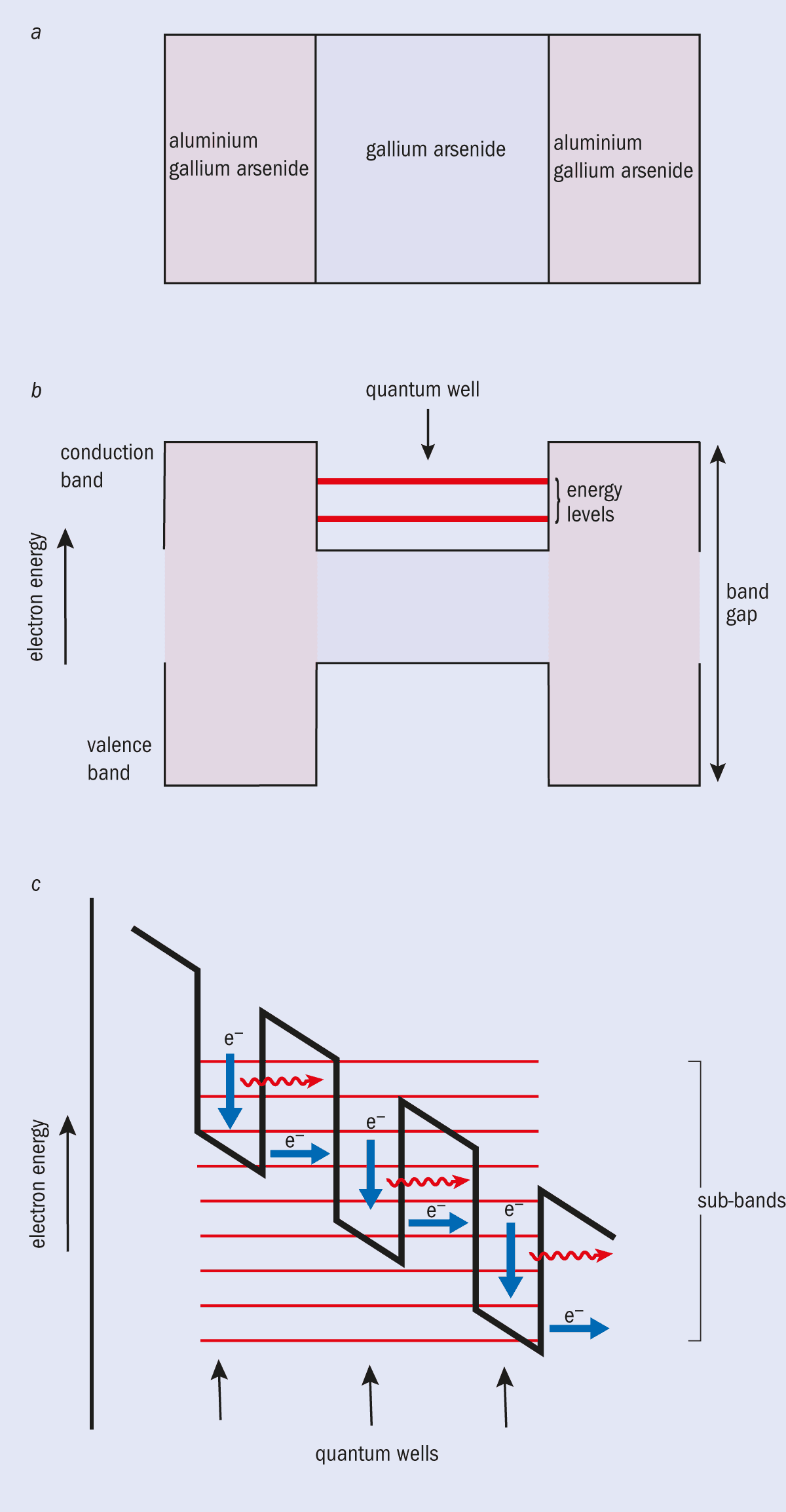
(a) Quantum cascade lasers consist of hundreds of alternating layers of high- and low-band-gap semiconductors. The low-band-gap material could be gallium arsenide (GaAs), while the high-band-gap material could be a derivative of aluminium gallium arsenide (AlGaAs). (b) This system forms a series of individual “quantum wells” in the GaAs. If each layer of GaAs is thin enough, the electronic energy levels in its conduction bands are split into a series of sub-bands. (c) Under an applied electric field, an electron that is injected into the structure can drop down from a high-energy to a low-energy sub-band, each time emitting a photon, which can be in the terahertz band.
The superlattices that the Leeds group uses are made from gallium arsenide sandwiched between layers of aluminium gallium arsenide (figure 1a). This arrangement creates a “quantum well”, which lets electrons move sideways along the gallium-arsenide layers but not down or up through the aluminium-gallium-arsenide layers unless it has enough energy to escape the well. Across many layers, the quantum wells act together to form sub-bands within the conduction band, creating a sequence of energy gaps (figure 1b). By applying a voltage, an electron starts to drop through these sub-bands, emitting a photon each time. By stacking units of these layered structures together into the overall superlattice, an electron continually drops through them, as though falling down a series of waterfalls (figure 1c).
The photons have about 100 times less energy than visible photons because the energy gaps between the sub-bands are 100 times smaller than the gap between the conduction and valence bands, which is typically around 1 eV. Since the physical width of the quantum wells determines the separation of the sub-bands and hence the energy of the photons, physicists can easily create structures to emit photons of any terahertz frequency desired. As Dean points out, it is the effect of these small sub-bands on the electron distribution in the laser cavity that renders QCLs immune to the problems of laser feedback, making his self-mixing interferometry method possible.
“You can open up these mini-gaps and inject electrons that drop across them,” says Davies. “Because they are small, the frequency is less than for a normal semiconductor. But that requires very significant development and the growth of layered semiconductor structures, which is why they have taken longer to develop, because we needed the materials research to catch up.”
Chilled out
These sub-bands are why terahertz QCLs have to be cooled. Thermal energy can easily excite the electrons to higher energy levels and, since the sub-bands are so small, it becomes increasingly hard to control which band the electrons are sitting in as the laser warms up. The first terahertz QCL in 2002 could only operate at temperatures up to 70 K. Moreover, it had to be pulsed so that the laser could cool between each terahertz burst. Today’s QCLs, which fire pulses of terahertz radiation that last less than 1 s, can run at 200 K, while continuous-wave QCLs work at up to 135 K.
So while there has been some improvement, cryostats are still needed. “I think where things have gone slower than we hoped when we developed the first terahertz QCL is with the temperature of operation,” says Davies. “It crept up gradually for a few years [but] has now plateaued, although there are new approaches to semiconductor design and materials that have the potential to address this.”
The dream of room-temperature terahertz generation has certainly not been extinguished. In fact, by bending the rules, one team led by Manijeh Razeghi at Northwestern University in the US has achieved just that.
Based at the university’s Center for Quantum Devices, Razeghi has been a world leader in semiconductor devices for several decades. After seeing the first infrared QCL demonstrated at low temperature and power by Jérôme Faist’s group at Bell Labs in 1994, she decided to maximize the possibilities for terahertz research. “I immediately tried for a room-temperature, continuous-wave terahertz quantum cascade laser,” Razeghi recalls.
How the feedback system works
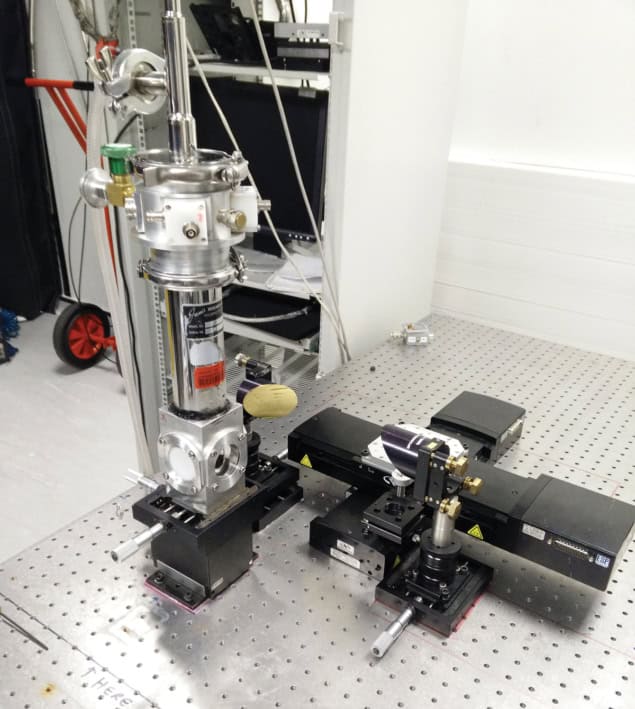
Terahertz scanners are large and bulky, but they could be drastically shrunk in size thanks to the “self-mixing interferometry” system developed by Paul Dean at the University of Leeds (see main text). His secret is to make the quantum cascade laser (QCL), which lies at the heart of the scanner, work double duty – acting as both the emitter and the detector.
The QCL produces a beam of terahertz radiation that is focused by a series of mirrors onto the target, such as a sample of body tissue. The radiation reflected back from the target then re-enters the QCL’s cavity via the mirror system, where it alters the electrical properties of the laser. A digital acquisition board measures the change in the voltage signal and sends it to a computer for analysis.
The system, which is about 1 m tall, could be miniaturized further and made more compact. The large silver cryostat (stacked vertically in the photo) can be replaced by a smaller cryostat that does not require cryogenic liquids. The mirrors, which have a focal length of 10 cm, could be replaced by lenses, shortening the optical system, while the black cross-shaped structure on the floor, which acts as the bed for the target sample, could also be shrunk.
In 2011 she achieved her dream. While terahertz QCLs have to work at cryogenic temperatures, mid-infrared QCLs have no such limitations because their band gaps are wide enough to function at room temperature. Razeghi and her colleagues therefore used a technique in which two mid-infrared QCL beams of marginal frequency difference are mixed together. When two photons – one from each beam – annihilate, they spontaneously produce a third photon with a frequency equal to the difference between the two lasers. If the two beams are designed to have a frequency difference between them equal to a terahertz frequency, then a terahertz photon is produced (Appl. Phys. Lett. 99 131106).
Initial experiments with this technique – known as “difference frequency generation” – produced just microwatts of power, but they proved the method worked. Now, in a new paper published in March in Scientific Reports (6 23595), Razeghi’s team reports having achieved milliwatt powers using this approach. “The people using cryogenic quantum cascade lasers have been working on them for a long time and have never gotten warmer than 135 K for continuous-wave operations,” she says. “That’s not very convenient for applications.”
Although Dean remains open minded over the promise of difference frequency generation, Davies is not yet completely won over. “While achieving room temperature is great, the power output is still quite low,” he says. “When you use a nonlinear technique, you inevitably lose the power. I guess it’s horses for courses.”
Quest for the killer app
As Razeghi points out, whether you have enough power or not comes down to how convenient a particular source is for a given application. In the case of Dean’s work with self-mixing interferometry for cancer screening, milliwatts do fine. For something requiring a stronger punch, then the cryogenic QCLs are so far the only way to reach high enough powers in a convenient, compact system. High powers are also needed to overcome the fact that terahertz radiation is strongly attenuated by water vapour in the atmosphere, in our bodies and in building materials.
Astronomers have long been aware of the effect of water vapour when studying terahertz light, being forced to build telescopes in this frequency band on high, arid ground so that the Earth’s atmosphere does not absorb all of the terahertz radiation en route from space. Indeed, observing atomic species in the upper atmosphere and performing astronomical observations are two of the most promising applications of terahertz technology, prompting the Leeds team to work with researchers at other universities and the Rutherford Appleton Laboratory to develop terahertz QCLs for satellite and space missions.
Back on Earth, estimates suggest that compact QCL terahertz sensors could be in everyday use within the next 10 years. For Dean’s work it might take a little longer, not because the technology isn’t ready, but because medical trials will need to take place too. Doctors will also have to be trained to know what to look for in a terahertz scan. “Within a medical setting, the time frames are probably a bit longer,” admits Dean. “On the other hand, something more straightforward such as scanning parcels for explosives or drugs with QCLs could be ready in a 10-year time frame.”
When that happens, terahertz physics will truly be able to join the rest of the electromagnetic spectrum in our everyday lives.

